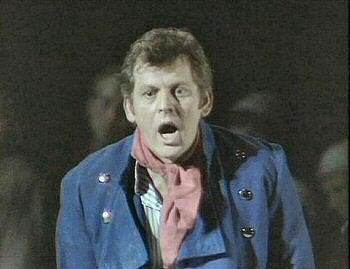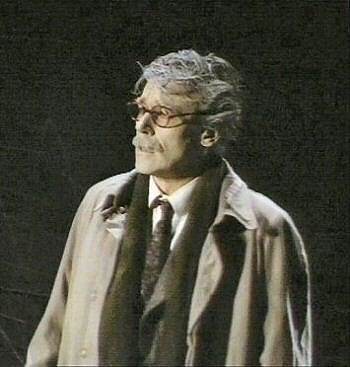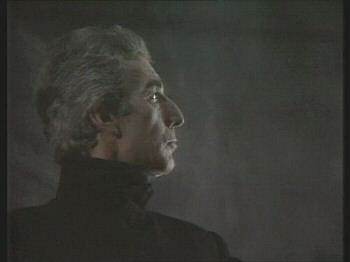
So far as I know, this is the only available
DVD version of 'Billy Budd'. The performance is in the revised
two-act version for television that Britten made in 1961, and
the disc comes with a booklet containing a detailed listing of
the opera’s numbers in English together with a plot synopsis
and commentary in German, English and French. The disc also includes
a short introduction by Michael Berkeley, which promises but fails
to deliver an interval talk with Eric Crozier, one of the works
librettists. The interview is not on the disc.
The libretto, written jointly by Crozier and the novelist E M
Forster, is based on the Herman Melville story ‘Billy
Budd, Foretopman.’ It recounts how in 1797, Billy Budd,
a virtuous young seaman with a stammer, is pressed into Royal
Navy service on the HMS Indomitable from a merchant ship called
the ‘Rights o’ Man.’ Billy is maliciously harried
by the ‘Indomitable’s’ Master-at-Arms John Claggart,
and after being falsely accused of mutiny he strikes Claggart
dead in front of witnesses and is hanged. According to the booklet,
the text is both Christian metaphor and a parable of implied homosexuality.
Tim Albery’s production creates a vivid picture of the
fear of mutiny prevailing at the time of the drama and of its
violent suppression. Though the commentary mentions Billy as a
Christ-like figure, Captain Vere as a ‘Pontius Pilate’
who sanctions Billy’s execution and Claggart as ‘the
incarnation of evil who sings a parodied version of a text from
St. John’s gospel to reveal his malice,’ all of these
elements are treated carefully. Only two direct allusions to them
are noticeable: the ‘holy-stones’ that the sailors
use to scour the ship’s decking and call ‘Bibles’,
are shown literally as books in the first scene, and Captain Vere
appears in modern dress in both prologue and epilogue; a symbol
of timeless guilt caused by the lawful but unreasoning destruction
of an innocent.

When the opera was first
written in 1951, male homosexuality
was illegal in England and references
to it, even within works of art, needed
to be veiled and unexplicit. The libretto
is therefore carefully crafted so that
its frequent references to Billy’s
‘handsomeness’ and to his
‘beauty’ could have been
defended (if required) as simple examples
of commonplace descriptive usage at
the time the drama is set. Charles Dibdin’s
famous song ‘Tom Bowling’
(written about his married elder brother
in 1789) says for instance :
Here, a sheer hulk lies
poor Tom Bowling, the darling of our
crew;
No more he'll hear the tempest howling,
for death has broach'd him to.
His form was of the manliest beauty,
his heart was kind and soft;
Faithful below, he did his duty, and
now he's gone aloft.
Although both law and
public opinion had changed for the better
by 1988, Albury’s production continues
to handle the homophilia issue tactfully.
The booklet’s claims that ‘Billy’s
appearance clearly triggers sexual fantasies
in both Vere’s and Claggart’s
minds, and (that) the latter…..wants
to destroy Billy because he desires
him’ are by no means obvious.
Unlike Covent Garden’s production
in September 2000 (Review)
there is little behaviour shown by Claggart
or Vere to suggest any physical attraction
to Billy and all action between them
can be read otherwise if we choose:
as the oppression of dissent by a fearful
authority mindful of recent mutinies.

The music is done very well. This is a fine version of one of
Britten’s masterpieces with excellent singing from everyone
involved. Assured conducting from David Atherton overcomes the
musical problems caused by an all-male cast and both Langridge
as Captain Vere and van Allen as Claggart give of their best.
When the production was first broadcast there was some criticism
that Thomas Allen was too old to play the fresh-faced Billy but
his singing is more than adequate compensation for those who find
his appearance unsatisfactory. Of the other cast members, John
Connell as Dansker is on particularly good form but there are
no poor performances at all. Recommended.
Comparative Audio Recording: Billy Budd,
Philip Langridge; Simon Keenlyside; John Tomlinson; Clive Bailey;
Mark Padmore; Richard Coxon London Symphony Chorus Tiffin Boys’
Choir London Symphony Orchestra / Richard Hickox.
Chandos CHAN9826 (3 discs)
Bill Kenny
Terry Barfoot has also
watched this DVD
Britten was always at his best when
he created around the central theme
of his preoccupation with persecution
and the corruption and loss of innocence.
In Billy Budd, which vies with Peter
Grimes for the accolade of being his
greatest opera, he uses a story by Herman
Melville as his source. The handsome
and simply virtuous sailor Billy Budd
suffers from a stutter that prevents
him from replying when he is deliberately
and falsely accused of mutiny by the
Iago-like master-at-arms John Claggart.
In his frustration he strikes out and
kills his accuser. Captain Vere recognizes
Buddís innocence but is weak in his
acquiescence. The operaís hero is therefore
hanged, but his death is somehow represented
as a symbol of redemption.
The story, then, is strong stuff, and
it is successfully transferred to the
stage through E.M. Forsterís immensely
skilful libretto adaptation. When the
project was in the process of creation,
Britten visited HMS Victory in Portsmouth
Harbour in order to gain an understanding
of the atmosphere and daily life on
board an 18th century warship.
This he succeeded brilliantly in capturing
in his music, and this aspect of the
opera provides both a challenge and
an opportunity to its interpreters.
It is a challenge that is largely by-passed
by Tim Alberyís 1988 production for
English National Opera. That this does
not matter so much is a tribute to its
other qualities, as well as to the standards
of the musical performances, and pf
course to the level of dramatic intensity
and characterization Britten and Forster
achieved.
For Albery opts to create a dark, sinister
society within the below-decks confines
of the ship, with the emphasis very
much on the characters rather than the
atmosphere of time and place. It is
a valid enough view, though it is also
a missed opportunity, particularly when
preserved in a DVD recording.
The pacing of the music and the drama
marks this work as one of the great
operas on the century. David Atherton
conducts with a masterly command of
ensemble and pacing, supported by a
cast who are committed to the cause.
Thomas Allen was associated with Billy
Budd for many years, and this production
was the last time he performed the role.
He looks and sounds the part, as does
Richard Van Allan in his portrayal of
the evil master-at-arms, John Claggart.
With Pucciniís Scarpia and Verdiís
Iago, Brittenís Claggart is one of the
grest villianís of the operatic stage,
a character for whom the destruction
of innocence is a prime concern. This
process allows Britten the opportunity
to create some of his most compelling
and moving music, with the result that
with each acquaintance the sensitive
listener will find the work more rewarding
still.
Given that this is a live performance,
the standards are remarkable, not only
of the conducting, singing and orchestral
playing, but also of the balancing of
the vivid recorded sound. Visually it
not the most exciting of experiences,
but that is part of the producerís approach.
In many respects the evil Claggart
is the star of the show. He certainly
controls the ship with an iron discipline,
relying on cruelty and deception at
every stage. With its close attention
to the more private scenes in the drama,
the production emphasises this the more
strongly. Van Allan is on excellent
form, not only vocally but also dramatically,
not least because he contrasts with
Thomas Allenís innocent, enthusiastic
Budd.
Philip Langridge is excellent too in
the role of the hapless Captain Vere,
a decent man who is caught amid circumstances
that he does not have the strength of
will to control. His final solos are
heartrending in their combination of
vocal tone and response to the text.
There are many important supporting
roles, all of which are well cast and
well sung by the members of a company
at the top of its collective form. And
the excellent chorus is full toned and
disciplined in every respect.
The version performed is Brittenís
later revision in two acts, which was
the version he preferred. The accompanying
documentation is adequate (unusual for
a DVD), with a useful introductory essay
and synopsis by Volkmar Fischer but
no biographical information about the
artists.
Terry Barfoot

